- Travel Guides
Indonesia Food and Drink
Exploding with a diversity of colors and spices, Indonesian food captures the panoply of flavors and cultures that populate its many islands. Rice served with meats and vegetables is the base of most meals, but foreign and local influences have created a delicious variety of native cuisine.
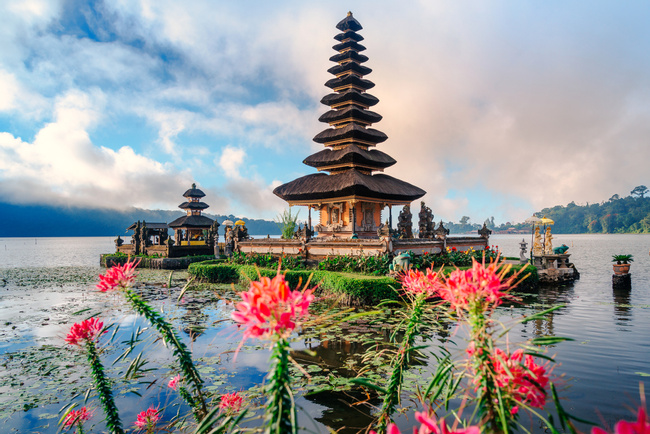
Overview
Indonesian food is influenced by the spice trade during the Age of Exploration. The Moluccas Islands, also known as Indonesia's Spice Islands, provided the world with flavors like cloves and nutmeg. Chinese, European, Middle Eastern, Pacific Islander, and Indian cuisines combine with indigenous cultures to create flavorful dishes that vary greatly by region. Indonesian cuisine is known for rich and complex spices, and many meals are built around a spice base (basa gede) made of peppers, garlic, shallots, ginger, turmeric, cloves, and other flavors. Some areas feature hot and spicy food, accented with a hot chili sambal paste.
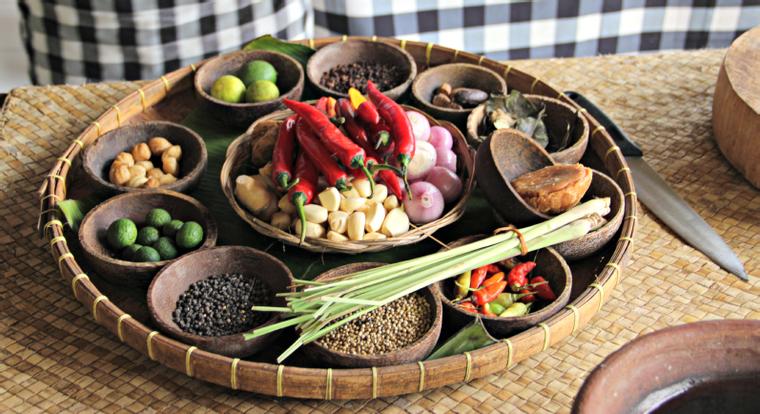
Most meals feature rice with sides of meat and vegetables, although there are also many noodle dishes. The national dish is tumpeng, a cone-shaped pile of rice in the center of a plate surrounded by sides and meat. Other famous Indonesian dishes include rendang (a slow-cooked meat dish) and nasi goreng (fried rice). Vegetarian options are easily found in local cuisine, as tempeh and tofu are common choices instead of meat. Shrimp paste may be used as a spice or cooking ingredients, so be sure to ask if this is a dietary issue.
Bali’s cuisine is less beef-oriented due to the island’s Hindu culture, while Lombok eschews pork due to the large Muslim population. Popular Balinese dishes include nasi campur, a scoop of white rice surrounded by a varied mix of sides and meats; lawar, a salad-like dish of chopped coconut, pork or chicken, spices and blood; bebek betutu, roast duck; babi guling, barbecued suckling pig; and sate made from minced meats, coconut, and spices.
Lombok Sasak culture has its own twist on Indonesian cuisine, with more tomato sauces and hot chilis than its island neighbor. Favorite Lombok dishes include ayam taliwang, a dish of spicy sambal grilled chicken; plecing kangkung, a vegetarian meal of cooked water spinach with a spicy tomato sauce; sate tanjung, a sate made with tuna marinated in coconut milk; and ikan bakar, fresh grilled fish.
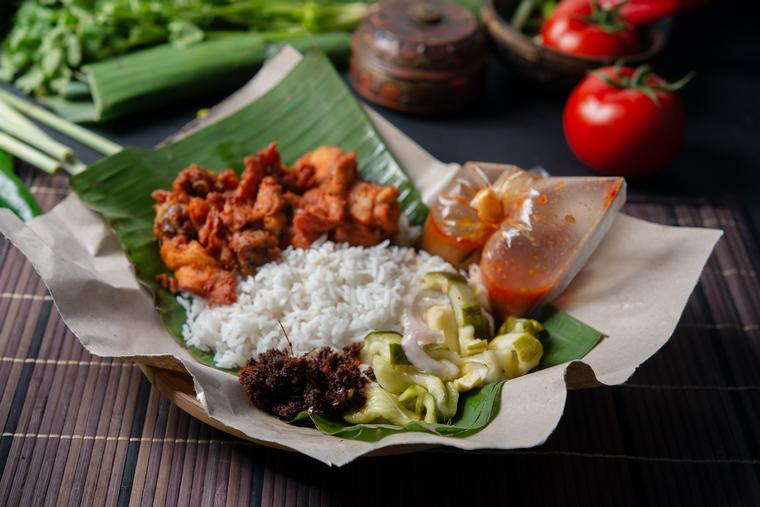
Visitors may find the mix of spices to be a little too rich at first, so it’s recommended to ease into the hotter dishes. Some Balinese foods such as lawar are made with blood, and it’s usually best to avoid these until your system becomes used to the local cuisine. Beware roadside barbecue stands with the letters “RW” prominently displayed, as this signifies dog as a primary meat ingredient. Sanitation has been greatly improved in more populated and touristy areas over the years, thus decreasing travelers’ chances of coming down with “Bali Belly.”
All in all, the cuisine is largely rich, healthy, delicious, and unbeatably cheap compared to Western prices. There’s something for everyone, especially in cities, and local restaurants are often tasty gems with a welcoming atmosphere.
Where To Eat
Bali is considered a foodie haven — there are no shortages of tantalizing places to eat at all price levels. Five-star dining experiences can be found at restaurants in the coastal town of Seminyak, where modern cooking trends and international cuisines are abundant. The cultural center of Ubud has its share of both top-shelf dining and a number of delectable vegetarian and raw options that are so good even staunch carnivores won’t have cause for complaint. Be sure to visit Jimbaran for a freshly grilled fish barbecue dinner on the sands of Jimbaran Bay.
Warungs, the Indonesian term for restaurants and small restaurants, are found throughout the island traditional Balinese and Indonesian cuisine as well as Western, Thai, Chinese, and Japanese options. All of these come at extremely affordable prices.
Lombok, while not as developed as Bali, has a number of great places to eat. Gili Trawangan has restaurants catering to every taste. Mataram City has a variety of restaurants and warungs, and Senggigi Beach has beachfront dining — perfect for a filling meal, cold beer, and a spectacular sunset. Warungs in Lombok tend more towards Sasak Indonesian and Balinese dishes.
Outside of restaurants, there are traditional markets that offer an authentic look at everyday dining in Indonesia. Both Bali and Lombok markets are filled with stalls bursting with bright, exotic produce and fruits. Be sure to try such local fruits as snake fruit and rambutan. Vendors show up before daybreak with spices, coffee, rice, and raw local meats such as chicken or fish. There are a number of food stalls serving everything from snacks to full plates of nasi campur or ayam taliwang.
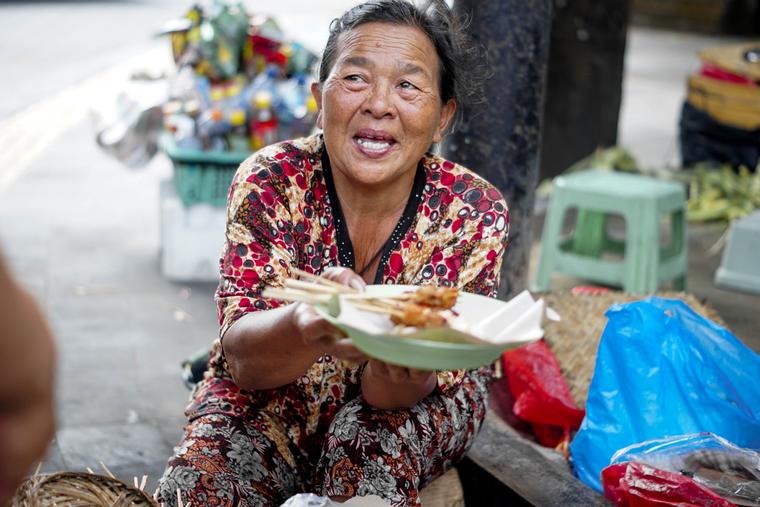
In Bali, there are a number of bustling local markets where you can experience a true taste of local culture. The Ubud Market opens early - 4 AM - and is a great place to buy fresh fruits and produce. Travel 20 minutes from Ubud by car to reach the Gianyar Night Market, which comes alive in the evening to serve chicken saté skewers and hot bowl of meatball soup, to name just a couple of popular options. Pasar Kereneng Market in Lombok is a huge affair that sells groceries during the day and at night fills up with food carts of all kinds.
In Lombok’s Mataram City, the Cakranegara Traditional Market sells handicrafts alongside fresh and prepared foods. Gili Trawangan night market is known as a backpacker’s seafood feast. It’s a one-stop food experience where the catch of the day is on sale next to more typical warung food. As you’ll come to expect in Indonesia, you’ll leave full but spend next to nothing.
Breakfast, Lunch, and Dinner
Lunch and dinner both feature rice as the staple. Breakfast varies only slightly, although resorts will typically serve a Western-style breakfast with coffee, the ubiquitous smoothie bowl, and everything from eggs benedict to waffles. A typical local warung breakfast might include a banana pancake, fresh fruits, toast, and kopi Bali – a local style of coffee similar to Turkish coffee, made by pouring hot water over unfiltered coffee powder.
Lunch and dinner in a local establishment might consist of soto ayam (chicken soup) garnished with shrimp crackers, or a perfectly shaped half cone of nasi goreng topped with a fried egg. Touristy restaurants will serve everything from burgers to pizzas, but these types of places are few and far between once you leave the more populated areas on the islands.
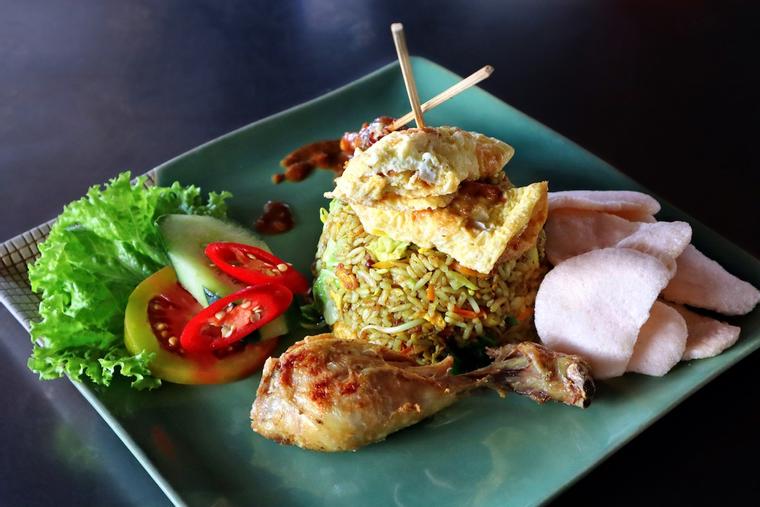
Popular local desserts include pisang goreng — bananas fried in batter — and terang bulan, a thick pancake with a variety of fillings such as condensed milk, chocolate sprinkles, crushed peanuts, and cheese. Bali chocolate has its own particular flavor and can be found in local stores or as part of other desserts at higher-end establishments. Gelato is also a common refresher in the hot weather.
Drinks and Alcoholic Beverages
Kopi Bali and teh panas (hot tea) are served just about everywhere. There are plenty of coffee shops with cappuccinos and flat whites. Luwak coffee (kopi luwak), made from coffee beans that have passed through the digestive tract of the civet, is considered a delicacy. There are coffee plantations where you can do tastings and see how the local brews are made.
When drinking water, it’s best to drink bottled or filtered water, not from the tap. Soft drinks and coconut water (in a fresh green coconut) are commonly available as well. Fresh fruit juices and healthy smoothies are a staple, as both islands have abundant orchards producing everything from papayas to bananas and mangos.
The most popular beer is Bintang, in its distinctive green bottle with the star on the label. There are a few small Balinese vineyards producing local wines from grapes of Australian origin.
Indonesia also has few very strong homemade alcoholic concoctions — some you could try from a high-end bar, but be very careful and don’t accept everything that’s offered. Tuak is a milky, rather sour-tasting palm wine which is often drunk midday. It’s even cheaper than arak, but doesn’t stay fresh long — it must be consumed the day it’s made. Arak is a Balinese liquor which is distilled from tuak, a sweet wine made from the coconut palm flower. Some arak is distilled from brem, which is a local rice wine made from black glutinous rice and coconut milk. Use caution when considering drinking any home-brewed liquor. Arak can contain over 50 percent alcohol. There are some good Araks, but also some very bad and lethal homebrews. Don't drink it from a budget place or with locals. At resorts and tourist restaurants, arak is usually served as a cocktail. The two most popular are arak madu (arak with honey) and arak attack (arak with sprite and lemon).
It's more than just having a good time or visiting beautiful places (although that's absolutely a part of it!), it's about being part of a unique experience that stays with you.



